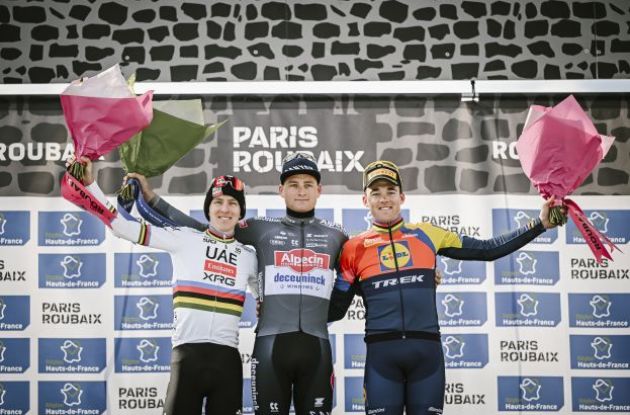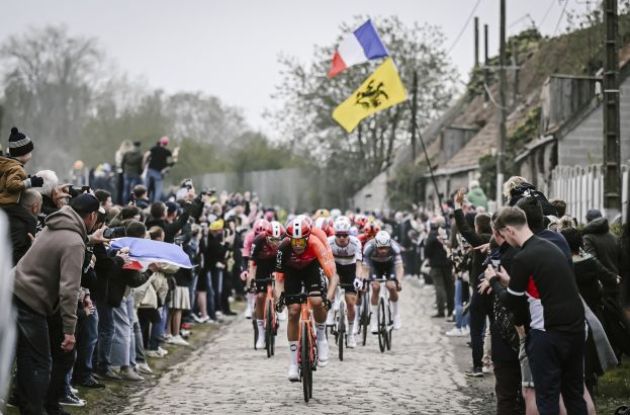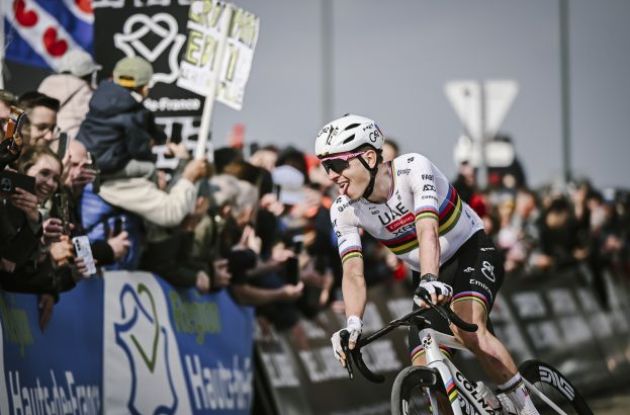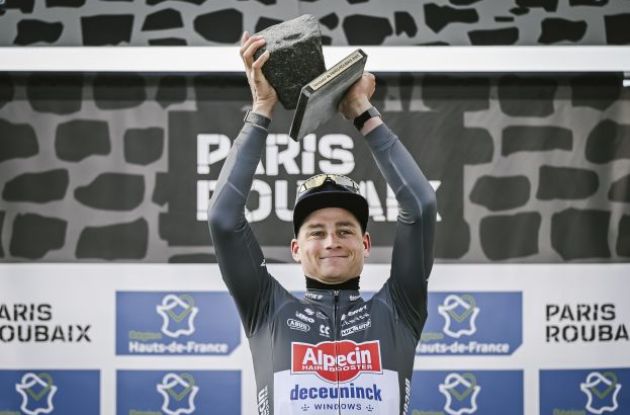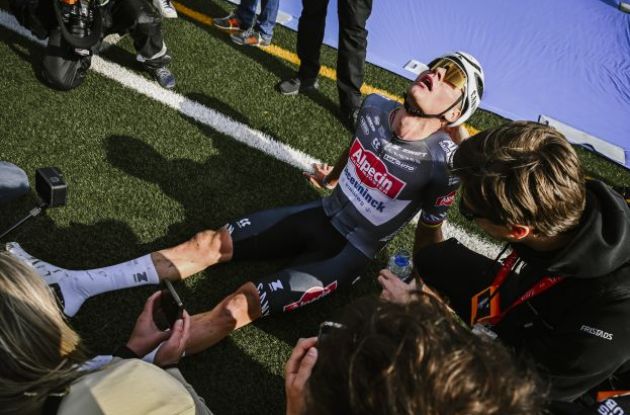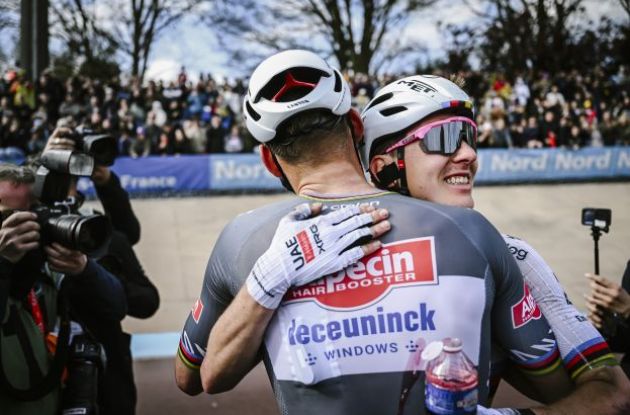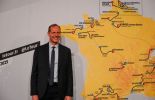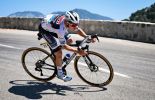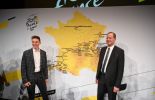Mathieu van der Poel Wins Paris-Roubaix
Sunday, April 13, 2025, had arrived – a date that most cycling fans around the world had marked with a big X in their calendars. Paris-Roubaix 2025 – the second of the five Monument races of the season - would be contested on the cobbled roads of northern France.
Prominent race organizer Amaury Sport Organisation had designed a route, which would take the riders across no less than thirty cobbled pave sections on the 259.2-kilometer route from Compiegne to Roubaix. No less than 55.3 cobbled kilometers would be contested, and the pave sections included the feared Trouee d’Arenberg (95.3 kilometers from the finish), Mons-en-Pevele (48.6 kilometers from the finish), and Carrefour de l’Arbre (17.1 kilometers from the finish). Following restoration works, the four-starred Quievy to Saint-Python cobbled section had been reintroduced with 154 kilometers left of the legendary race known as the Hell of the North.
The favorites to take the victory in this year’s Paris-Roubaix included defending Paris-Roubaix champion Mathieu van der Poel (Alpecin-Deceuninck), who had the opportunity of securing a historic hattrick in the race, and teammate Jasper Philipsen, who was known for his skills on the cobbles and his great sprinting abilities. Mads Pedersen (Team Lidl-Trek) had shown great form by winning Gent-Wevelgem and finishing second in Ronde van Vlaanderen. The Dane wanted to win this race more than any other. Filippo Ganna was leading the Ineos-Grenadiers team, and the Italian strongman was expected to fare well in Paris-Roubaix as were Wout van Aert and Dylan van Baarle of Team Visma-Lease a Bike.
Despite contrary advice from his UAE Team Emirates sports directors, World Champion Tadej Pogacar had decided to participate in Paris-Roubaix 2025 – a race which posed a significant risk of crashing and suffering injuries that could put his Tour de France ambitions at risk. A victory for Pogacar in Paris-Roubaix would be the first victory for a Tour de France winner in the race since Bernard Hinault in 1981.
Outsiders included Stefan Küng (Groupama-FDJ), Tim Merlier (Soudal-QuickStep), Biniam Girmay (Intermarche-Wanty), Kasper Asgreen (EF Education-EasyPost), Anthony Turgis (Team TotalEnergies), Ivan Garcia Cortina (Movistar Team), and Alexander Kristoff (Uno-X Mobility) in the final Paris-Roubaix and final Monument race of his career.
Riders gathered behind the start line in Compiegne and the Paris-Roubaix started. It had rained during the night, but the roads were slowly drying up. While the middle parts of the roads were dry, rain had accumulated near the sides of the roads, where many riders preferred to ride to avoid the cobbles.
It did not take long before riders started launching breakaway attempts from the front of the peloton as many riders were eager to join an early breakaway for tactical reasons. Despite many efforts, no viable breakaway group had been established after twenty kilometers.
Eight riders had established a narrow lead when 225 kilometers remained. The riders were Kim Heiduk (Ineos-Grenadiers), Oier Lazkano (Red Bull – Bora – Hansgrohe), Markus Hoelgaard (Uno-X Mobility), Jonas Rutsch (Intermarche-Wanty), Max Walker (EF Education-EasyPost), Jasper de Buyst (Team Lotto), Rory Townsend (Q36.5 Pro Cycling Team), and Abram Stockman (Unibet Tietema Rockets).
The eight frontmen had expanded their lead to 45 seconds with 220 kilometers left of the hellish race in which all the cobbles were yet to come.
The breakaway optimists continued to work hard and cooperated well to increase their advantage. They had built a lead of almost three minutes 200 kilometers from the finish line.
The grand champions had sent their lieutenants to the front of the main peloton to battle for positions when 180 kilometers remained. It was important for the teams to be optimally positioned at the front when the riders reached the first cobbled sections, which would shake up both the peloton and the riders. Riders from Ineos-Grenadiers, UAE Team Emirates, Lidl-Trek, and Alpecin-Deceuninck were at the front of the main peloton.
Wout van Aert and Matej Mohoric crashed 172 kilometers from the finish. Then Jasper Philipsen and Laurence Pithie crashed with 161 kilometers remaining. Ineos-Grenadiers riders were pulling at the front of the peloton when the riders entered the cobbled section.
Tough luck for Ineos-Grenadiers, whose team leader Filippo Ganna suffered a punctured tire on the cobbles just as the team was setting a fast pace at the front of the peloton. The eight breakaway optimists were still in front with a 02:42 minute lead.
Riders including Jasper Philipsen, Filippo Ganna, Ivan Garcia Cortina, and Connor Swift were chasing hard to rejoin the peloton while the riders were contesting cobble section 29 Viesly a Quievy.
Quievy Saint Python was next on the cobbles menu. Its four-star classification indicated rough challenges ahead for the riders. Lidl-Trek riders were leading the peloton while Tadej Pogacar was spotted near the front. The Ganna group was still more than a minute behind the main peloton with 150 kilometers remaining.
141 kilometers remained and the riders entered the cobble sector 26. The front part of the main peloton was now 01:42 minutes behind the eight frontmen, while the Ganna group was chasing 02:30 minutes behind the front.
Anthony Turgis (TotalEnergies) tried his luck from the front of the peloton 137 kilometers from the finish line. He did not establish a viable advantage.
The Ganna-led chase group joined the main peloton 130 kilometers from the finish. Pogacar’s lieutenant Nils Politt attacked from the front of the main peloton at approximately the same point.
With additional crashes occurring, the riders reached cobbled sector 24 and then sector 23. The speed was intense, and the teams were slowly starting to fight to set the agenda and fight for positions at the front of the favorites peloton.
Querenaing to Maing – sector 22 – was next on the racing menu. 120 kilometers remained and the Alpecin-Deceuninck team was leading the main peloton. The peloton had reduced the lead of the eight breakaway frontmen to 01:15 minutes at this point.
The riders were approaching sector 20, Haveluy to Wallers, the final cobbles before the feared and legendary Trouee d’Arenberg. Full attention, good legs and great fighting will was required from the riders who had ambitions in today’s Paris-Roubaix.
Mads Pedersen moved to the front of the peloton and increased the pace. Tadej Pogacar attacked. A small group featuring quite some race favorites was established. The riders were closing in on Trouee d’Arenberg. Mathieu van der Poel, Jasper Philipsen, Mads Pedersen, Tadej Pogacar, Wout van Aert, Stefan Küng, and Stefan Bissegger were all present. The front eight were now only a few seconds ahead.
Trouee d’Arenberg – the legendary five-star cobbled section – greeted the riders. Tadej Pogacar led the favorites onto the Arenberg stretch closely tailed by Mads Pedersen. Van der Poel moved to the front.
The eight breakaway optimists were caught on the Arenberg cobbles. Motorcycles and reeled in riders were causing quite a lot of confusion on the cobbles, which should have been one of the climax points of the legendary race.
A new front group featuring approximately fifteen riders was established. The group featured van der Poel, Philipsen, Pedersen, Pogacar, Giani and Florian Vermeersch, Matthew Brennan, Joshua Tarling, Stefan Bissegger, and other big names.
Mads Pedersen attacked with 88 kilometers left of the race. Pogacar responded with other riders. Mathieu van der Poel accelerated and built a lead. Tadej Pogacar closed the gap with Pedersen on his wheel. Bissegger joined the fun with Philipsen.
The front quintet reached sector 17, Hornaing to Wandignies. 82 kilometers remained. Their advantage was 36 seconds at this point. Van der Poel was pulling. The case group was headed by Stefan Küng.
With van der Poel and Philipsen a few meters behind, Tadej Pogacar attacked with 71 kilometers remaining. At the same time Mads Pedersen suffered a flat tire and had to stop. Stefan Bissegger remained in the mix.
Van der Poel and Pogacar formed a front duo. Philipsen accelerated from the chase group, hoping to join teammate Van der Poel in the front duo. Philipsen joined, thereby creating a front trio.
Bissegger was chasing behind, while Mads Pedersen was approximately one minute behind following his flat tire experience at the worst possible point in the race.
The front trio reached section 14 – Beuvry to Orchies with sixty-five kilometers of the Hell of the North race remaining.
Mads Pedersen was displeased with the performance and lacking courage of the other riders in the chase group. The great Dane, therefore, chose to attack solo, hoping to bridge the gap to the front trio. Their advantage, however, was 01:20 minutes with 56 kilometers left, so his chances were slim.
Pedersen’s chase effort was later joined by van Aert, Bissegger and other riders. Their deficit was still 01:20 minutes.
The riders approached Mons en Pevele – one of the three key points in the legendary Paris-Roubaix classic. The five-starred cobbles section was feared by many riders in the professional cycling peloton. At first the two Alpecin-Deceuninck riders led the trio on the cobbles, but Pogacar later moved to the front and increased the pace.
Defending Paris-Roubaix champion Mathieu van der Poel attacked with 46 kilometers left, but Pogacar clung to his rear wheel. Philipsen got dropped. Pogacar moved to the front.
Pogacar and van der Poel were still in front forty kilometers from the finish line in the Roubaix velodrome. Philipsen was 25 seconds behind, while a group featuring Wout van Aert and Mads Pedersen were 01:30 minutes back.
Having increased the pace to 60 km/h, Pogacar crashed in a corner, hit a hole and slipped in the mud with 38 kilometers left and defending Paris-Roubaix champion van der Poel pressed on solo in front.
Van der Poel reached cobbled section 8 in solo fashion with a lead of fifteen seconds over Pogacar. Jasper Philipsen was 01:37 minutes back, while Pedersen and van Aert were 01:43 behind the race leader.
Bourghelles to Wannehain was next on the race menu and Mathieu van der Poel continued to increase his advantage over Pogacar. His lead was now 22 seconds.
Pogacar stopped to switch to a different Colnago bike with 21 kilometers left. The bike switch took a while, and he was now 47 seconds behind.
The riders entered Carrefour de l’Arbre (section 4) – the final five-starred pave stretch in the legendary race. This was the final dangerous cobbled section of the race and where the race outcome could be significantly influenced by crashes and mechanical issues.
Mathieu van der Poel suffered a mechanical issue in the Carrefour de l’Arbre sector and had to receive a new bike from his team car. He fought on in relentless fashion.
With thirteen kilometers remaining, Van der Poel was still solo in the lead. Pogacar was 01:05 minutes behind the strong Dutchman. Florian Vermeersch, Wout van Aert, and Mads Pedersen were now forming a chasing trio behind Pogacar.
Eight kilometers remained and van der Poel was now passing through pave sector two. Things were status quo as Pogacar was 01:05 minutes behind, and the Pedersen-Van Aert-Vermeersch trio was two minutes back.
Wout van Aert attacked from the chase trio with two kilometers left. Vermeersch and Pedersen tried to respond.
Mathieu van der Poel was the first rider to enter the velodrome in Roubaix. The Alpecin-Deceuninck rider crossed the finish line in solo fashion as winner of Paris-Roubaix 2025. It was the third consecutive Paris-Roubaix victory for Dutchman van der Poel.
World Champion Tadej Pogacar (UAE Team Emirates) was the next rider to enter the velodrome. Pogacar finished second in the race, despite crashing during the race.
Vermeersch, van Aert and Pedersen entered the velodrome together. Mads Pedersen started his sprint for third place and succeeded. The Danish strongman beat Wout van Aert and Florian Vermeersch.
“It means a lot to win today. It was a hard race, and I was really suffering,” race winner Mathieu van der Poel told Roadcycling.com after the finish. “I just had to go for it, and it was really hard with the last two sectors with the headwind,” van der Poel added.
“The speed was superhigh and I think Pogacar misjudged the turn a bit when he crashed, so I just had to go for it, it is part of racing. I didn’t know the time gap between us, because my radio wasn’t working. I couldn’t get in touch with my team car when I had to switch bikes,” van der Poel explained.
“Pogacar is an exceptional talent and what he did today is not normal. Perhaps he will get his revenge in next year’s Paris-Roubaix,” van der Poel pondered.
Stay tuned to Roadcycling.com for complete coverage from the 2025 professional cycling season.

